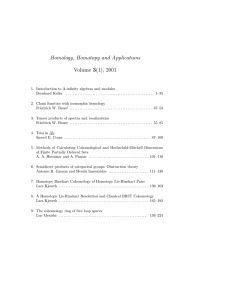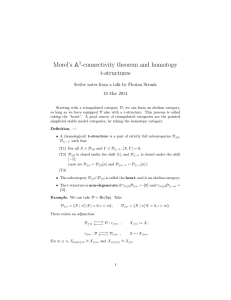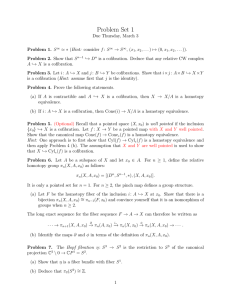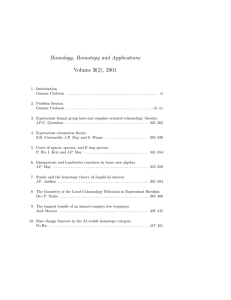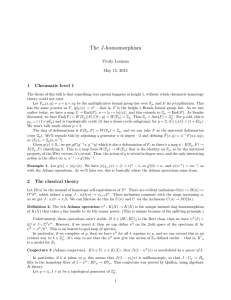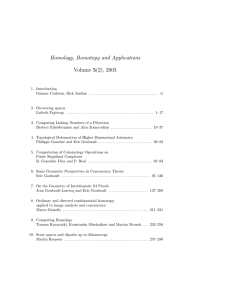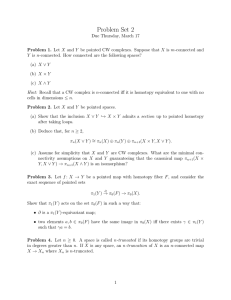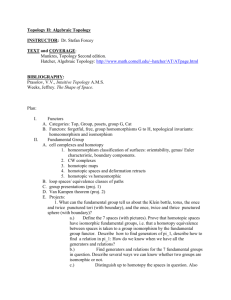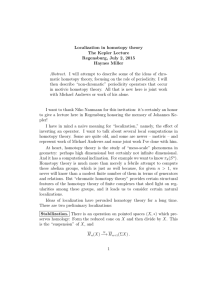“Chromatic” homotopy theory Haynes Miller Copenhagen, May, 2011
advertisement
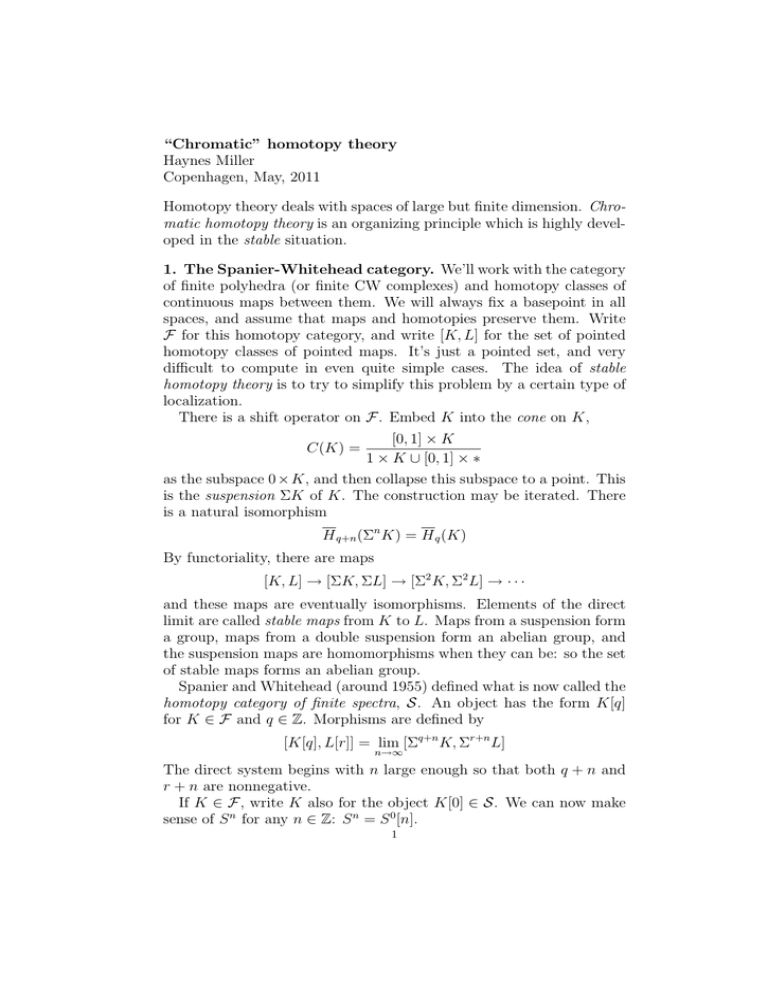
“Chromatic” homotopy theory Haynes Miller Copenhagen, May, 2011 Homotopy theory deals with spaces of large but finite dimension. Chromatic homotopy theory is an organizing principle which is highly developed in the stable situation. 1. The Spanier-Whitehead category. We’ll work with the category of finite polyhedra (or finite CW complexes) and homotopy classes of continuous maps between them. We will always fix a basepoint in all spaces, and assume that maps and homotopies preserve them. Write F for this homotopy category, and write [K, L] for the set of pointed homotopy classes of pointed maps. It’s just a pointed set, and very difficult to compute in even quite simple cases. The idea of stable homotopy theory is to try to simplify this problem by a certain type of localization. There is a shift operator on F. Embed K into the cone on K, [0, 1] × K C(K) = 1 × K ∪ [0, 1] × ∗ as the subspace 0 × K, and then collapse this subspace to a point. This is the suspension ΣK of K. The construction may be iterated. There is a natural isomorphism H q+n (Σn K) = H q (K) By functoriality, there are maps [K, L] → [ΣK, ΣL] → [Σ2 K, Σ2 L] → · · · and these maps are eventually isomorphisms. Elements of the direct limit are called stable maps from K to L. Maps from a suspension form a group, maps from a double suspension form an abelian group, and the suspension maps are homomorphisms when they can be: so the set of stable maps forms an abelian group. Spanier and Whitehead (around 1955) defined what is now called the homotopy category of finite spectra, S. An object has the form K[q] for K ∈ F and q ∈ Z. Morphisms are defined by [K[q], L[r]] = lim [Σq+n K, Σr+n L] n→∞ The direct system begins with n large enough so that both q + n and r + n are nonnegative. If K ∈ F, write K also for the object K[0] ∈ S. We can now make sense of S n for any n ∈ Z: S n = S 0 [n]. 1 2 For X, Y ∈ S, [X, Y ] is an abelian group. In fact S is an additive category, with K[q] ⊕ L[r] = (Σn+q K ∨ Σn+r L)[−n] for any n making both n + q and n + r nonnegative. Even better, it is triangulated. The distinguished triangles are those isomorphic to cofiber sequences. In F the cofiber of f : K → L is the pushout in f K - ? ? CK L - L ∪f CK The cofiber maps to ΣK by collapsing K to a point. The shift functor in this triangulation is given by ΣK[q] = K[q + 1]. There is an ∼ = isomorphism (ΣK)[q] −→ K[q + 1]. The The category S of “finite spectra” offers a useful “first approximation” to homotopy theory, in the words of Spanier and Whitehead. It embeds in a larger triangulated category of spectra as the compact objects. Define the homotopy and homology of K[q] by πr (K[q]) = [S r , K[q]] = lim πr+n (Σq+n K) n→∞ and Hr (K[q]) = H r−q (K) 2. Constructions. Let p be a prime number and consider the homotopy class of maps S n → S n of degree n. These suspend to each other, and define a map p : S 0 → S 0 in S. It is non-nilpotent: no iterate is ever null-homotopic. This is seen by applying homology to compute the degree. The first element of p-torsion in π∗ (S 0 ) is in degree 2p − 3, and is written α1 : S 2p−3 → S 0 . (When p = 2 this comes from the famous Hopf map S 3 → S 2 .) The identity pα1 = 0 has a geometric implication. A map S n → S n of degree p can be used to attach an (n + 1)-cell to S n : S n ∪p en+1 . This construction is compatible with suspension, and defines a finite spectrum written S 0 /p or S 0 ∪p e1 . 3 Let q = 2p − 2 and consider p p S 0 ∪ e1 S q ∪p eq+1 p p p p p p 6 Sq pp pp pp pp pp pp sp Σα1 - ? S1 6 p Sq The diagonal arrow records the null-homotopy of pα1 = α1 ◦p. The top arrow exists by virtue of a harder computation, due to Frank Adams, which is valid only when p > 2. We now have a self-map of S 0 /p, v1 : Σq S 0 /p = S q /p → S 0 /p Even though it has nonzero dimension, you should think of it as an analogue of p : S 0 → S 0 . In particular you can iterate it: neglecting to indicate suspensions of maps, S qt /p v1 - S q(t−1) /p v1 - ··· v1 - S 0 /p 6 S Σαt qk ? - S1 The composite αt defines a new and high dimensional element in the homotopy of the sphere spectrum. It is actually a well-known class, in the “image of the J-homomorphism.” Larry Smith showed that this may be repeated, as long as p ≥ 5: let S 0 /(p, v1 ) = S 0 /p ∪v1 C(S q /p) This has “cells” in dimensions 0, 1, 2p − 1 and 2p. There is a map 2 −1) v2 : S 2(p /(p, v1 ) → S 0 /(p, v1 ) 4 which we may use to create more elements in high dimensional homotopy: S 2(p2 −1)t v2k /(p, v1 ) - S 0 /(p, v1 ) 6 S 2(p2 −1)t βt ? - S 2p 3. Detection. This is the constructive side of the story. It is not clear though that these elements are nonzero!—you need some analogue of the degree. This is provided by a certain family of homology theories, known as Morava K-theories. These are functors on S that satisfy a MeyerVietoris property making them computable. The zeroth member of this family is just K(0)∗ (X) = H∗ (X; Q). Thereafter there is a family for each prime p. K(1)∗ is very closely related to topological complex K-theory, but in general K(n)∗ is more novel. K(2)∗ is related to “elliptic cohomology.” The maps vn are such that K(n)∗ is nonzero on the spectra and K(n)∗ (vn ) is an isomorphism. This shows that vn is non-nilpotent. It takes more work to show that αt and βt are nonzero, but they are. 4. The Periodicity Theorem. These are hard computations in the Adams spectral sequence, and they seem to represent very special situations. This turns out not to be the case, however! This is the content of work of Ethan Devinatz, Mike Hopkins, and Jeff Smith, from the 1980’s. If X ∈ S is such that H∗ (X; Q) = 0, then the homotopy type of X splits as a finite wedge of spectra each of which has homology which is p-torsion for a single prime p. Let Sp denote the category of p-torsion finite spectra. Let Sp,n be the category of p-torsion finite spectra for which K(n − 1)∗ (X) = 0. Its objects are said to be of type n. Theorem. [Ravenel [4]] If X ∈ S then K(n)∗ (X) = 0 ⇒ K(n − 1)∗ (X) = 0. This implies that Sp,1 ⊇ Sp,2 ⊇ Sp,3 ⊇ · · · It is far from clear that the strata are nonempty, and a construction is needed to show this. 5 Theorem. [Devinatz, Hopkins, Smith [1]] Let X ∈ Sp,n . There exists n k a map φ : Σ2(p −1)p X → X such that K(n)∗ (φ) is an isomorphism and K(i)∗ (φ) = 0 for i > n. The map φ is a vn -self-map. The maps v1 and v2 are examples. Theorem. [Devinatz, Hopkins, Smith [1]] Let X, Y ∈ Sp,n , and f : n k n l X → Y . Let φ : Σ2(p −1)p X → X and θ : Σ2(p −1)p Y → Y be vn -selfmaps. There exists an integer m with m ≥ k and m ≥ l such that the diagram f n −1)pm Σ2(p φp X - m−k n −1)pm Σ2(p θp ? X Y m−l f ? - Y commutes. In particular, take f to the identity map on X: this says that any two vn -self-maps have homotopic iterates. On the category Sp,n , there is an “ideal operator” acting, well defined up to iterates. The labor involved in constructing the self-maps v1 , v2 , wasn’t in vain; but some power of them exists automatically by this theorem. 5. Localization. This leads to the following challenge: For a finite p-torsion spectrum X of type n, compute n k φ φ φ−1 π∗ (X) = lim π∗ (X) −→ π∗ (Σ−2(p −1)p X) −→ · · · → The only known examples occur when n = 0 or n = 1. When n = 0, we are looking at a finite spectrum whose homology contains an infinite cyclic summand (and, say, no p0 -torsion). A v0 self-map is given by multiplication by p, and Serre proved that p−1 π∗ (X) = H∗ (X; Z[1/p]) When n = 1 we have the computation (for p > 2) [3] v1−1 π∗ (S 0 /p) = Fp [v1±1 ]hi, ai where α i 1 i : S 0 −→ S 0 /p and a : S 2p−3 −→ S 0 −→ S0 /p 6 References [1] M. J. Hopkins and J. H. Smith, Nilpotence and stable homotopy theory. II. Annals of Math. 148 (1998) 1–49. [2] H. R. Miller, D. C. Ravenel, and W. S. Wilson, Periodic phenomena in the Adams-Novikov Spectral Sequence, Annals of Math. 106 (1977) 469–516. [3] H. R. Miller, On relations between Adams spectral sequences, with an application to the stable homotopy of a Moore space, J. Pure Appl. Alg. 20 (1981) 287–312. [4] D. C. Ravenel, Localization with respect to certain periodic homology theories, Amer. J. Math. 106 (1984) 351–414.

